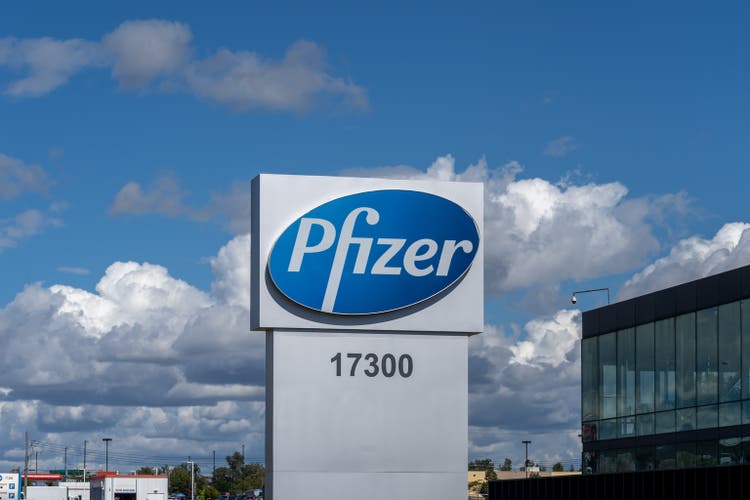JHVEPhoto/iStock Editorial via Getty Images
I published my first article on Pfizer (NYSE:PFE) at Seeking Alpha on the 8th of February 2021. In that article, I argued that Pfizer was a ‘Strong Buy’ case, and that the upside was as clear as the sun. Since then, Pfizer’s shareholders have benefited from 43% returns, while the S&P 500 fell during the same period by 4.5%.
Valuation still compelling, and exponential growth continuing
So is Pfizer starting to look expensive? Not at all. Quite the contrary. Revenues doubled between 2020 and 2021, to reach $80 billion – well above the $70-72 billion range that was forecast by the company one year ago. And operating income, well, tripled. This leaves us with a P/E of 11 times, and market cap to operating cash flow of 8.9 times. The P/E is exactly at the same level of one year ago, while market cap to operating cash flow ratio has halved due to impressive management of working capital that provided a $12.8 billion boost to operating cash flows in 2021. The dividend yield is still a respectable 3%, and net debt is only $10 billion, which can be fully paid down using operating cashflows of 3-4 months. This helps Pfizer maintain the comfortable credit rating of ‘A’ Stable from Fitch, and keeps Pfizer safe financially from increasing interest rates.
Pfizer continued its exponential growth in Q1 2022, with revenues growing by 82% year-on-year, and EPS growing by 76%. And this is not only due to the COVID vaccine – even without it, Pfizer is doing well. At $13 billion, sales of Comirnaty, the rebranded COVID-19 vaccine, represented more than 50% of total sales of $25 billion. Revenues of Eliquis, a medicine used to reduce risk of strokes and blood clots, grew by 12% in Q1, achieving sales of $1.8 billion versus $1.2 billion in Q1 2021. Sales of Vyndamax, a medicine to treat heart failure, grew by an impressive 41% to reach $612 million.
In full year 2022, Pfizer is expecting sales of between $98-102 billion. To give an idea of the scale of progress; this would be 150% times the annual sales between 2018 and 2020, and a quarter higher than the sales of 2019 and 2020 combined. EPS is expected to range between $6.25 and $6.45, giving shares a forward P/E ratio of around 8x at today’s price of $52.5 per share. Super cheap. Given how accurate Pfizer’s forecasts have been for the 2021 results, it would be fair to expect that their 2022 estimations should be accurate as well. This would provide investors with a rare chance of stability in the current turbulent world where investors and policy makers are unable to forecast what happens economically in the near future.
Outlook and pipeline are strong
The elephant in the room for Pfizer’s investors is of course that the bumper profits of the COVID vaccines will not be repeated in the future. This keeps a lid on Pfizer’s valuation. But stripping out Comirnaty from the equation still leaves Pfizer with a decent valuation at today’s share price. Compared to a current P/E of 11x and market cap to operating cash flows of 8.9x, the other major vaccine producer, AstraZeneca (AZN), is trading at a negative P/E (following losses in 2021) and an eye watering market cap to operating cash flow of 27 times. Merck’s (MRK) P/E is 17x, and Denmark’s Novo Nordisk (NVO) trades at 37 times.
In addition to a strong pipeline of drug development, Pfizer has been making good use of its bumper cashflows to make bolt-on acquisitions of biopharma companies. Earlier in May, it acquired Biohaven Pharmaceuticals for $11.6 billion in cash. Biohaven’s main drug Rimegepant has been approved in both the U.S. and Europe for treatment as well as prevention of migraines.
Pfizer also boasts that it has industry-leading results for end-to-end success rates for clinical trials of new drugs – succeeding in one fifth of trials compared to less than one tenth for the industry, and one in twenty for Pfizer before 2015. The company foresees a bright future, with CAGR sales growth expected to be more than 6% annually in the next five years.
Clouds could be gathering in the future
Pfizer is facing the expiry on patents of several key drugs between 2025 and 2027. Add to that the clear likelihood that the bumper profits of the COVID-19 vaccine will not be recurrent, and the medium term future looks certain for investors. But Pfizer does have an impressive pipeline of drugs development; 96 in total, including 6 in registration stage, 29 in Phase 3 and 31 in Phase 2. GSK, Pfizer’s partner in the consumer healthcare venture, has 64 drugs under development, only 21 of which are in pivotal studies. Johnson and Johnson, the largest healthcare group in the world, has 94 drugs, including 40 in Phase 3 and 23 in Phase 2.
Pfizer is generating enviable sums of cash from its COVID-19 vaccine. These sums will only increase with the planned listing of the consumer healthcare business that is owned jointly between Pfizer (32%) and GSK (68%). Pfizer had indicated its intention to sell its stake through the listing, which could generate up to $19 billion in proceeds.
Pfizer is in a unique position in its history with gushers of cash flowing in from everywhere. Pfizer will use this cash to power future growth through its drug pipeline, innovation, and acquisitions, which will secure promising returns and profitability for investors in the year ahead. Pfizer is definitely one of the most attractive healthcare investments around.


Be the first to comment